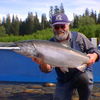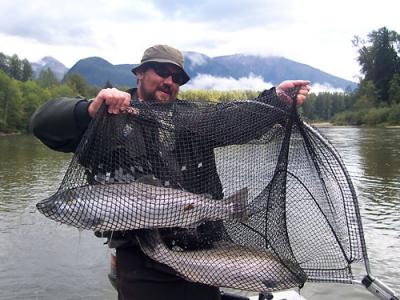OCT0BER Record Coho 1996 by Noel F. Gyger
This is a fantastic time to angle for both steelhead and Coho salmon plus resident Cutthroat, Rainbow Trout and Dolly Varden Char in northwest British Columbia Canada. Let's talk about the Coho salmon first.
You too can make this dream a reality if you come here to angle for these beautiful salmon. When hooked they jump, roll and tumble, wrapping themselves up in you line, like a pretty package. The rolling and tumbling is a Coho characteristic! The Americans know them as "silvers"....but we call them "Yo Ho"...the Coho! The Skeena River and its many tributaries are fortunate to have many large runs of these "silver" beauties. The first migrating Coho are of average size but later, in October, the "larger" Coho start to appear. We call these larger fish "northerns" because, not only is their average weight higher, they also have the distinctive large "hooked" nose that we commonly refer to as the "northern nose". Even the females have the hooked nose although not as prominent as the male. The regular Coho average between 6 and 12-pounds but the "northerns" average between 12 and 20-pounds with the odd fish weighing more than 25-pounds. Northwest Fishing Guides lodge record fish weighed an amazing 27-pounds. This fish was landed by a repeat guest, Mr. Jack Baikowitz, in middle October 1995 in the Kasiks River. Mr. Baikowitz now wants to be called "Mr. Coho" from now on. A 20 x 30 inch poster photo of this record fish hangs on the wall at the lodge. Yo Ho! That's the "battle cry" in the fall that most of us yell when the Coho start coming. This is a very exciting time of year.
The Coho arrive into the Skeena system at the beginning of August. The smaller Coho enter the river first as they have the furthest to travel. The "BIG" Chinook Salmon runs are coming to an end and all but over. Even though there are still Chinook Salmon in the rivers, most are getting too dark and usually left alone to spawn, prefer to angle for brighter fish. If you talking "table fare"...why would anyone want to kill a dark fish? Everyone's attention turns to the bright silver Coho Salmon. A good angler can hook many more Coho than Chinook. Nature dictated that the smaller fish will be more plentiful. What a great way to end the salmon season...with "blow-out" Coho fishing.
This is the most "anti" combat angling area you can find anywhere, especially in the fall. Many time when fishing for Coho you will be the only person in the pool. I am referring to the isolated coastal rivers, only accessible by jet-boat, near Terrace. My favorite river is the Kasiks. The jet-boat ride up this river is fantastic. For 8 miles you wind your way upstream through mountain flanks that touches the river on both sides. Slate gray rock faces confined the river to a narrow slot. A thousand tiny waterfalls skittered down the rock faces plunging into the small river.
Even though the runs are strong in our area, it is still wise to practice conservation. We want these Coho here forever. Please lean the correct way to catch and release and teach your friends. It will work for Coho as well as it has been proven to work for Steelhead. Do not stress a fish by playing it too long (usually caused by using too light a line) or dragging it in too quickly, so that it beats its head on the rocks. Keep the fish off the rocks and in deep water. The angler should be wearing chest waders or at least hip waders so he can accomplish this. Use "barbless" hooks or hooks that have small barbs, such as Gamakatsu. To assist in landing a fish use a glove or sock to grip the tail. For a large fish use a glove on both hands. Do not pick them up only by the tail and lift them high into the air as this puts too much stress on their backbone. Keep the fish horizontal by supporting the belly with the other hand. Do not use a landing net as the mesh can cause excessive scale loss and split fins. Try and keep their head in the water as much as possible, then hold them up for a quick "kiss" and photo then let them go. Take the hook out gently. If you do this correctly you will not need the pliers. If the fish has the strength to wiggle its tail, let it "kick" out of your hand and swim, do not hold it back. Celebrate!
If you keep a fish to eat, make sure that it is silver and fresh. Do not keep a dark fish as it is probably too near to spawning and the meat will not make good table fare.
One basic rule applies when fishing for Coho: if you can't see them rolling, don't fish. Coho like just about any terminal tackle that is properly presented. Presentation is everything. And to have some fun with the colors they should be silver, blue or green. I love using the flyrod in a weight 8 or 9 or a light spinning rod and reel filled with 12-pound test and a jig as terminal tackle. The jig works well in very clean water, calm or slow moving deep pools where you know fish are holding and you cannot see them, except for the odd "roll" or "rise" now and then. If you find a pool or run where you can see the fish because the water is very clear and not that deep, your terminal tackle choice should be a lure such as the Lure Jensen Krocodile or a light thin spoon weighed if needed, with split shot. Use something thin that glides through the water and is designed to represent small fish that the Coho think are a threat to their spawning "reds" or area. Sometimes a spinner such as the Blue Fox #4 or 5 is the correct bait. The spinner blades cause it to be retrieved slowly, letting the fish have a good look at it and thereby making a decision to strike. With other terminal tackle, such as thin lures most folks retrieve them too quickly. Slow down your retrieve. I know this will cause you to lose a few lures but you have to be down deep and your lure has to be moving slow enough to give the fish a chance to react. Always keep you hook sharp. After awhile, not matter what your using or how you present it, the fish will spook or develop "lock jaw" and stop biting. In that case, you are advised to find another "fresh" or un-spooked pool.
Float fishing or bottom bouncing works the best when the water is higher, the fish are not spooked and the current is moving at the correct speed. Many types of terminal tackle will work when float fishing but I think the best bait is "dime size" egg bags fished on number 2 hooks.
October is "PRIME TIME" for "wild" B.C. Steelhead in our area. They are referred to as wild because there are no hatchery steelhead in the whole Skeena River and its tributaries. Both conventional and fly tackle users will be in "heaven". The main rivers we fish are the Skeena, Copper and Meziadin. We also fish in the Meziadin Lake. At this time of year the lake is full of spawning Sockeye Salmon, consequently the fishing for Dolly Varden Char is fantastic. These are big Dolly's that weigh up to 6-pounds and Rainbows to 5-pounds. At the end of the lake, where the lake turns into river is the best spot in the world for steelhead and Coho fishing. The river is jammed with fish. No matter how bad the weather, this river remains fishable all the time.
Another river in our area, called the Copper, excellent for Steelhead at this time. Care must be taken when wading this river because the bottom is strewn with large and small boulders and one can trip over them if not careful. If the water is very clean, the flyrod will hook many fish. Convention tackle users will have no trouble hooking up to six or more fish per day.
Our lodge record steelhead weighed 32-pounds. It was caught and released by Dennis Therein from the Kalum River in 1995. It measured 40 inches in length and had a girth of 24.5 inches. The weight was estimated by using a formula of length x girth squared x 1.33 divided by 1000. We have a 20 x 30 inches poster photo of this fish at our lodge. I did not get any video footage of this fish, to include in our season REVIEW 1995, because I forgot my video camera.
The angling guides have their own photo album which they call "book of honors". Each season, the angling guide takes at least 200 to 500 photos of his guest's fish...then he selects the top 24 photos and puts them in his album. Through the season, as he develops each roll of film, he edits out photos that are in the album for better ones and by the end of the season he has his "top" 24 photos that make up his "book of honors".
The best advertising that you can have is when a satisfied guest tells his friend what a fantastic trip he had. We love answering the telephone and hear the person on the other end saying that we are "highly" recommended by one of our previous guests. That tells me that we must be doing something right. Also, what is very satisfying is that many of our guests return year after year, sometimes twice a year.
We house guests in a clean modern lodge on the outskirts of Terrace. Costs are a reasonable $600 US (2007 rates) per full fishing day which includes meals, lodging and guiding. Call us at (250) 635-2568. This number is also a fax. Their internet address is www.noelgyger.ca . To receive WEEKLY FISHING REPORTS and PHOTOS via e-mail send your name and e-mail address to Noel Gyger noel@noelgyger.ca They have several 2-hour "year in review" feature videos from 1987 to present for a cost of $40 US each.
To have a successful trip, you need: (1) a good run of fish, (2) proper timing of the runs, (3) good water and weather conditions. We cannot control water conditions, but with so many watersheds available, quality angling can always be found. We will do our very best to ensure that you have a great fishing trip. A stay with us is more than us a "vacation" - we sell adventure! With our special attention, we hope you come as a guest, leave as a friend and return many times.
See you soon.Full contact info for:
Noel Gyger
Phone: 250-635-2568
E-mail: noel@noelgyger.ca
Website: www.noelgyger.ca
SIGN UP to receive his Weekly Fishing Reports via e-mail on his website at www.noelgyger.ca Just click the yellow box (left side)



